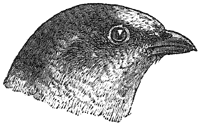|
Page 30 | prev page next page | ||
|
Order IV. ZYGODACTYLI
The second order of Picarian birds comprises the Indicators or Honey-guides, the Barbets, and the Toucans (Ramphastidae), the last being peculiar to South America. All of these have zygodactyle feet like Woodpeckers, with the first and fourth toes directed backwards, and the picine arrangement of the deep plantar tendons, the flexor perforans digitorum running to the third toe only, whilst the first, second, and fourth toes are supplied by branches of the flexor longus hallucis, as shown in the accompanying figure by Garrod. The muscles of the thigh, too, in the present group, present the same arrangement as in Pici; the spinal feather-tract is similarly disposed, the oil-gland is tufted, and there are no caeca. The nidification, too, is similar. On the other hand, the vomer in the present group, instead of being represented by a number of paired rods, is single and bifurcate, and the palate is either truly desmognathous, the maxillo-palatines blending across the middle line, or aegithognathous. The sternum, too, presents some characteristic differences, being much broader, especially in front, in proportion to its length, and the breadth in front being nearly the same as that behind, instead of much less; the foramina or notches on the posterior border are deeper, the manubrium or rostrum sterni is pointed and not bifid, and the clavicles do not meet to form a furcula. Tongue of ordinary structure, not protrusile. The two Indian families of this order are thus distinguished (the characters do not apply to some African forms): Key to the Species
Tail-feathers 12, primaries 9 .... Indicatoridae Family INDICATORIDAE
Bill stout, short. Tail-feathers 12 (except in one aberrant African genus). Wing long
and pointed; only 9 primaries; no short primary, the first nearly as long as the second.
Ventral feather-tract forked on the throat, but not on each side of the breast. Ethiopian
and Oriental regions. A single genus is found in India. |
| ||
|
Tarsus short, all toes well-developed, 3rd (outer anterior) longer than 4th (outer posterior). Bill finch-like; culmen rounded, the profile considerably curved; no nasal plumes nor rictal bristles; nostrils large, sub triangular, partly covered by a membrane, Tail somewhat graduated, the outer pair of rectrices in several species, as in the Indian one, considerably shorter and narrower. This genus contains several African species and the only two Oriental members of the family; one of these is Himalayan, the other, I. archipelagicus, is Malayan, not ranging into Tenasserim. The African Indicators frequently point out the position of bees’ nests, and hence have received the name of Honey-guides. Throughout Africa these birds are said to lead men to bees’ nests for the sake of sharing in the spoil. Nothing is known of similar habits in the Indian and Malay species, though they appear, like the African, to feed on hymenoptera. The Honey-guides, like Woodpeckers and Barbets, lay white eggs in a hole in the stem or branch of a tree, but they are said to utilize an old nest-hole of a Barbet or Woodpecker for the purpose.
Coloration: Broad forehead, edges of a few sincipital feathers, and cheeks golden yellow. Crown and sides of head including area round the eyes, back and sides of neck dusky yellowish olive, feathers of the crown with dark centers. Feathers of upper back and scapulars, wing-coverts and quills blackish brown, all except the primaries and their coverts narrowly fringed with yellowish olive; inner webs of secondaries and tertiaries with whitish margins. Middle of back pure yellow, lower back and rump orange-yellow; upper tail-coverts and tail-feathers blackish brown, except the outermost (shorter) tail-feathers, which are paler and greyer; lower parts dark grey. The chin, throat, and foreneck tinged with yellow; breast and abdomen with blackish shaft-streaks, broader behind vent. Feathers and under tail-coverts blackish with pale edges; wing-lining whitish, edge of wing buff. Bill yellow, ashy towards the tip; iris dark brown; naked orbital area pale green; feet pale greenish horny (Stoliczka).
Size: Length about 6; wing 3.8; tail 2.4; tarsus 0.6; bill from gape 0.5 Distribution: This species, which is very rare, has hitherto been found only in the Himalayas, in Sikkim, and also near Murree and Abbottabad, but nowhere in the intervening area.
Habits: The only published observations are by Stoliczka, who shot a
male close to Dungagali near Murree. This bird had a heavy flight like
Megalaema and in the stomach were several specimens of a predatory wasp
and small quantity of green vegetable matter. | |||
| prev page :: next page | |||
 birding.in
birding.in
| Birds | Bird Diagram | Ornithology | Indian Sites | Bird Watching | Migration | North India | Birds of India | Haryana |
All rights reserved. Copyright © 2005-2013 Birds and birding in India. Disclaimer
website: Free Java Guide & Tutorials

